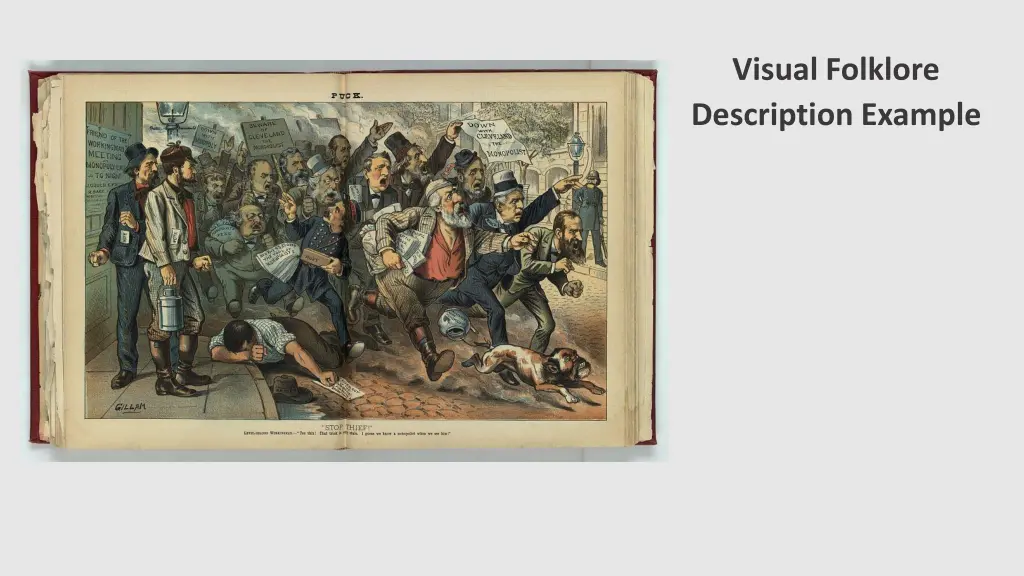
Folklore Cartoon: Stop Thief! Illustration
Explore a visual folklore description example through the illustration "Stop Thief!" by Bernard Gillam, published in 1884. This cartoon, reminiscent of Thomas Nast's work, features a group of characters reacting to the cry of "Stop thief!" amidst a political satire setting. Dive into the intricate details and symbolism depicted in this historical piece. The image is part of the Library of Congress collection and offers a glimpse into the socio-political context of the time.
Download Presentation

Please find below an Image/Link to download the presentation.
The content on the website is provided AS IS for your information and personal use only. It may not be sold, licensed, or shared on other websites without obtaining consent from the author. If you encounter any issues during the download, it is possible that the publisher has removed the file from their server.
You are allowed to download the files provided on this website for personal or commercial use, subject to the condition that they are used lawfully. All files are the property of their respective owners.
The content on the website is provided AS IS for your information and personal use only. It may not be sold, licensed, or shared on other websites without obtaining consent from the author.
E N D
Presentation Transcript
Visual Folklore Description Example
Visual Folklore Description Example Stop Thief! by Bernard Gillam, published by Keppler & Schwarzmann, August 6,1884. This image is in the Library of Congress.
Visual Folklore Description Example Illustration, reminiscent of Thomas Nast's cartoon of the same title published in Harper's Weekly, October 7, 1871. [It] shows a group of monopolists and Blaine supporters scattering on the street in response to the cry Stop thief! Joseph Keifer carries a sign that states Beware of Cleveland the Monopolist and Cyrus Field waves a sheet that states Down with Cleveland the Monopolist.
Visual Folklore Description Example Among the pursuers and those being pursued are William W. Phelps, Benjamin F. Butler carrying a bag of Monopolist Fees, Robert Ingersoll, Keifer, George M. Robeson, Whitelaw Reid throwing dust in the eyes of workingmen, Alonzo Cornell, Field, James G. Blaine carrying a bag of $ from Monopolists and R.R. Stocks, Russell Sage, John Roach, and Jay Gould, as well as a dog with the face of John Kelly(?), and with a teapot labeled Alliance with Monopolists tied to its tail.
Visual Folklore Description Example all are determined to look like pursuers, instead of the object of the pursuit. Carl Schurz, dressed as a policeman, is standing on the sidewalk at far right. Two laborers are standing on the left, next to a sign that announces Friend of the Workingman Meeting at Monopoly Hall To Night - J. Gould, C. Field, R. Sage, Robeson.
Visual Folklore Description Example
Visual Folklore Description Example This cartoon is taken from page 16 of the Hale Scrapbook 1746-1830. As is noted on their website: The massive Hale scrapbook contains rare British cartoons, engravings, letters, and clippings dating from approximately 1746 to 1830. The original creator of the scrapbook is unknown, but it was probably made to document the history of the time period and to provide a source of entertainment.
Visual Folklore Description Example [The cartoon] makes fun of Caroline Herschel, the first woman to be paid for her work in the sciences. Born in 1750, she became interested in astronomy while assisting her brother, William, who discovered the planet Uranus and was George III s court astronomer. Caroline independently discovered eight comets, including two in 1790, the year this cartoon was published.
Visual Folklore Description Example The cartoonist ridicules her, perhaps for stepping outside the bounds of the accepted domain of women at the time. In 1828, Caroline Herschel became the first woman to be awarded the Gold Medal of the Royal Astronomical Society. She remained the only woman to receive this prestigious award until 1996.






















